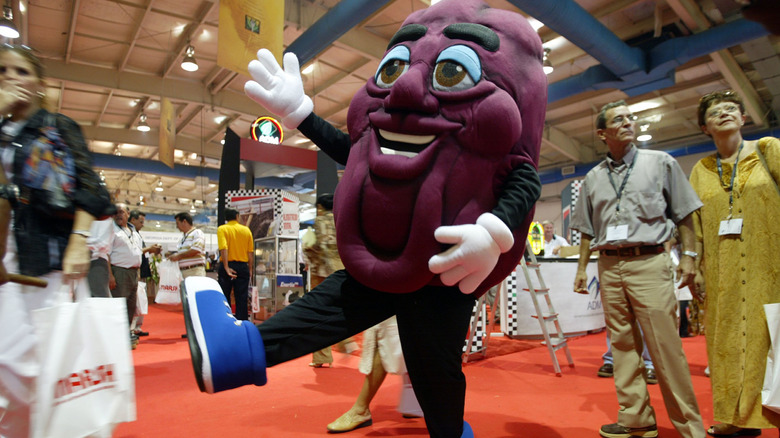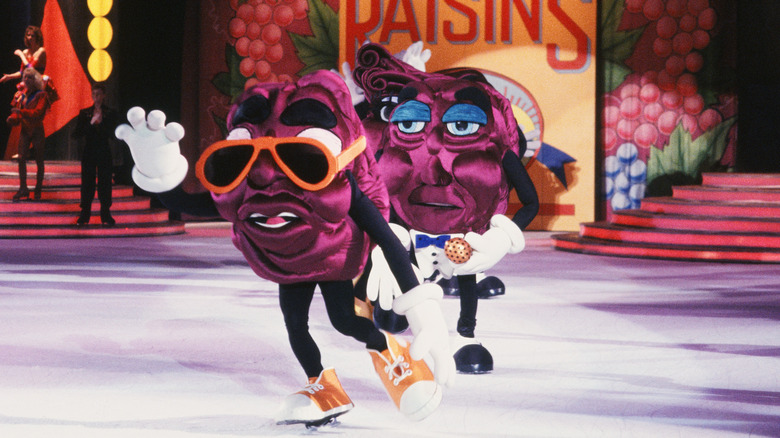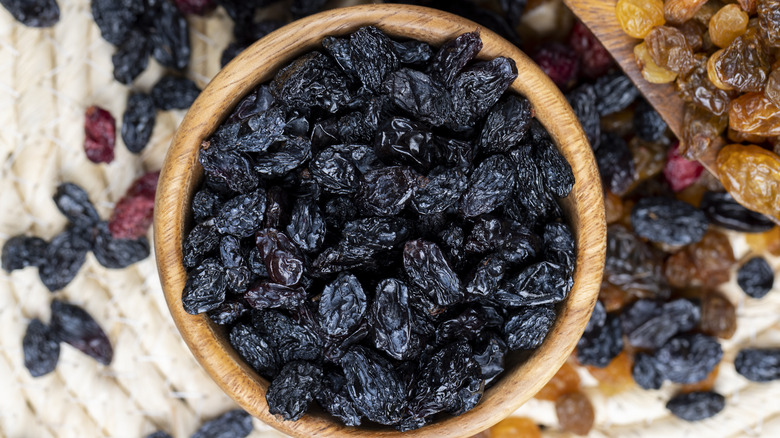The Wacky Origins Of The Iconic California Raisins
Let's get real for a second: Raisins are not typically considered cool. They have their positives: Raisins are beneficial to runners, and you can make them yourself from grapes in the air fryer. But raisins are hardly stylish or memorable. They're just ... there.
But there was a brief period during the 1980s and '90s when raisins suddenly did become cool, thanks to the California Raisins. As unbelievable as it seems now, these generalized mascots for raisindom became enormously popular almost overnight, supercharging raisin sales by 20% and eventually crossing the barrier into other media as a band composed of anthropomorphic raisins playing various musical instruments. In part, their success was novelty and general good marketing, but another aspect was what can only be described as pure art. Claymation wasn't significant in the entertainment scene when the California Raisins hit screens. In many ways, the entire medium — "Wallace and Gromit," "The Nightmare Before Christmas," "Coraline," all the classics we know today — owes its popularity, at least in part, to the California Raisins.
Ad execs had to get creative to try to sell raisins
Promoting raisins is not easy; early '80s commercials established their nickname as "nature's candy," but it's unclear how seriously anyone took that. So if raisins were going to get a popularity boost, they needed to try something different, to think outside the (tiny rectangular) box. So in 1986, ad writers working with Foote, Cone, & Belding on behalf of CALRAB (the California Raisin Advisory Board) decided to do precisely that. Their solution was a fictional band paired with Motown R&B classics, specifically the aptly-named "I Heard It Through the Grapevine."
The team could have just gone with plain animation for its concept, but that wasn't quite far afield enough. So, instead, the agency turned to a guy named Will Vinton, one of the biggest names in stop-motion animation at the time. Vinton had done food commercial work before — his studio was the one that came up with Dominos' infamously creepy Noid — but raisins weren't exactly as easily marketable as pizza. Vinton, however, gave it a shot with the first commercial debuting in 1986 — although there's no way he could've foreseen what his creation would unleash.
The California Raisins' success went beyond commercials
There have been popular ads that cross over into other products, but many attempts are outright disasters (remember the ill-fated GEICO caveman TV show?). Not only were the California Raisin commercials popular enough to eventually attract the attention of Michael Jackson for a commercial, but they became successful beyond TV. The fictional group spawned real albums, TV specials, action figures, a video game, and even an Emmy nomination for a mockumentary based on their exploits. The Sun-Maid raisin girl may be an advertising classic, but she never got her own video game.
From 1986-1991, the California Raisins ruled the advertising roost. Though they were eventually left behind as mascots, with a 2015 plan to bring them back failing to launch, their legacy was startling. Before the California Raisins, food itself was rarely depicted as essentially an edible mascot (the Kool-Aid Man being a notable exception), meaning those M&M's commercials that have been going for decades were likely a result of the Raisins — as Vinton told Food & Wine, "The Raisins opened up a floodgate. Everything had to be personified."
Beyond that, the claymation field suddenly became much more popular, with "Wallace and Gromit" making its debut in 1989 and "The Nightmare Before Christmas" hitting theaters in 1993. Would these projects have attained mainstream popularity without the California Raisins? Maybe. But it seems difficult to deny that the Raisins paved the way.


